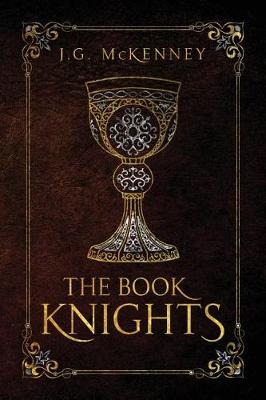Reviewed by Kate (Blogging with Dragons) on
Actual Rating: 2.5 stars
I really liked the premise of the The Book Knights—Fahrenheit 451 meets Arthurian legend. As a massive book nerd, The Book Knights was a dream to read, it offers a secret order of librarians, Grail Tomes, word fighting, and magical pens that rewrite the future. But while I really enjoyed the premise of the novel, I felt the execution was lacking. I found the portrayal of characters and the world building confusing. This book also felt more geared towards younger audiences than towards young adult readers.
I loved the portrayal of Arthurian characters in a modern world, which is definitely the biggest strength and appeal of the novel. The bond between main character Arti Penderhagen and her friend Gal (modern day Arthur and Galahad), was really special and something I enjoyed immensely. Arti promised to teach Gal how to read, something strictly forbidden in Morgan Fay’s dystopian world, if Gal taught her how to survive on the streets, where Arti found herself after the imprisonment of her reading parents. I really adored how each character came to love books in their own unique journey—something that every reader experiences, but was more intensely felt in this dystopian universe, where books were outlawed and burned and its readers persecuted.
I especially loved the characterization of the villains of the novel. Morgan Fay sought to rid the world of the power of words, burning all books she could find in order to reach the final page of her Grail Tome. Once on the final page, Morgan could write the future to her own liking, which would be very, very bad for lovers of the written word and the rest of the general populace who would be forced to worship her. Mordred in this book, Morgan’s captain of the Incendi police, was a very compelling villain. Mordred wielded words, known as the Verses, as deadly weapons and hunted for the Challenger—the one who could stop Morgan—Arti.
Arti and her (Book) Knights of the Round Table were all female except Lance, based on Lancelot. I felt it odd that that he was the only male Knight and thought he stuck out like a sore thumb. I am guessing the author made him male instead of female simply so he could have an eye roll inducing instalove with Gwen. I would have much preferred that the author kept with his motif of female knights and then just included a lesbian romance. Instead, this hetero romance felt like a cop-out. On the other hand, I was also expecting a love triangle as per the classic Arthur-Gwenevere-Lancelot tradition, but there was none, which also felt like a letdown. However, the fact that the Knight’s Round Table was in a motorhome was so freaking clever and characteristic of the enjoyable quirkiness of the novel.
The decisions about the characters were not the only thing that confused me, I was also perplexed by the world-building in the novel. I was puzzled by the description of the areas in the novel. Even after finishing the book, I am uncertain whether the entire world took place in the Isle of Avalon, which may or may not have been just a city? Though the author states that Merl, the Merlin of this tale, travels far and wide to procure books, the details of which were not explained.
I did feel that the writing style of this novel was not as detailed or complex, and was in fact, a little cheesy and focused on telling, rather than showing. For instance, when Arti and Gwen finally start bonding, it is described as, “From that moment on, despite the four years that separated them in age, Arti and Gwen were like friends at a sleepover, whispering stories well into the night.” I find this type of “telling” unnecessary, but it is something that younger readers may not mind. For older readers, it may be a turnoff. And though the book attempts to give each character a deep background with complex motivations, it feels superficial and like it only scratches the surface. This is something else that would not be as big of a problem for younger readers.
Similarly, I did not care for what I felt was an overly perfect ending, with Arti being almost magically reunited with her formerly imprisoned parents and the immediate adoption of Gal as her sister, but honestly, the epilogue sounded amazing! I would read the next book in this series, but know to expect a light, fun read that would be more suitably geared towards younger audiences.
Book Review Policy
Connect with Me:
Reading updates
- Started reading
- 27 June, 2018: Finished reading
- 27 June, 2018: Reviewed
